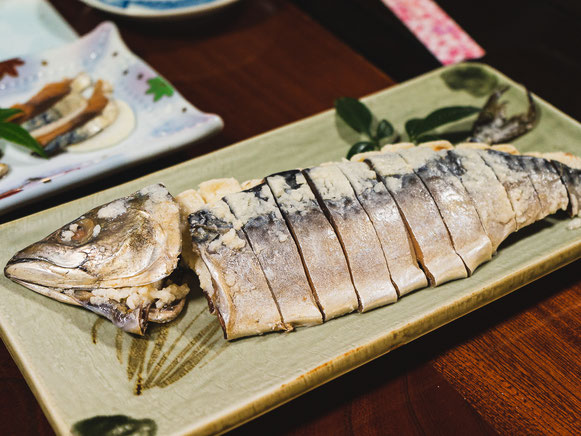Or How an Elementary School was Transformed into a School of Fish
BY JOSHUA BEWIG
Tagarasu Elementary School, in its new incarnation as Heshiko processing plant
As its rural population ages and declines, Japan faces (among other dilemmas) a glut of vacant elementary schools. The solution for this fishing village was to repurpose its old school into a heshiko processing plant, where the tradition of naturally preserving fish is passionately carried on.
The hamlet of Tagarasu, whose name means “crows in the rice paddies”, lies at the edge of the ancient port city of Obama, overlooking Wakasa Bay on the Sea of Japan.
This region was once an independent province known as Wakasa. Given its proximity to the former capitals of Nara and Kyoto, and its extraordinarily rich fishing grounds, Wakasa
enjoyed the exalted status of miketsukuni. This meant that it was obliged to provide food offerings to the imperial court.

While heshiko is believed to have originated during the Edo period, it belongs to an older tradition of preserving food using salt and fermentation. These methods arose out of the necessity of delivering high quality seafood to Nara or Kyoto via the ancient network of roads now known as the Saba Kaido - or “Mackerel Highway”.

Heshiko remains a local delicacy of the Wakasa area, and involves salting and fermenting fish for over a year. It is generally made from mackerel, but herring is also popular.
The process consists of cutting the fish open to remove the organs, thoroughly cleaning it, and then salting and storing it in barrels under pressure for two weeks to remove any excess fluid.
The salt is then rinsed off and the resulting brine is collected in buckets to be used later. The fish is stuffed and coated with nuka - or rice bran - and carefully repacked in the barrels, leaving as little empty space as possible.
When a barrel has been filled, a loosely braided rope of rice straw is placed around the edge, and it is topped off with more nuka. This assures a snug fit when the lid is placed on top.
Chopped togarashi chili pepper is then sprinkled over the lid to ward off insects. Finally, a weight is added to keep the contents under pressure, and the brine that was set aside earlier is added to further pickle the fish and assure that no air finds its way into the barrel.
Then wait a year or so and, presto!

Heshiko is a nutritious source of DHA, protein, dietary fiber, and healthy enzymes. Perhaps it will be lauded as a superfood one day, and Tagarasu's heshiko will become a household word.
It pares well with a cup of dry sake, and is often served sliced thin over a wedge of daikon radish, grilled, or as chazuke – a kind of rice gruel made with tea.
Because the flavor is vaguely reminiscent of anchovies, I find it goes well with pasta sauce, on pizza, or with cheese and crackers. Other successful experiments include potato salad and bagna cauda.

If you've acquired a taste for heshiko and want to challenge your tastebuds further, next try narezushi. Narezushi is heshiko that has been fermented an additional couple of weeks stuffed with koji – or malted rice. This is the true origin of sushi as we know it today.
While heshiko is becoming more common throughout Japan, it is still difficult to find. The best way to try this delicacy is to visit Obama yourself, where it's readily available everywhere from restaurants to supermarkets.
Be sure to let me know in the contact form if you need any help planning your itinerary.









